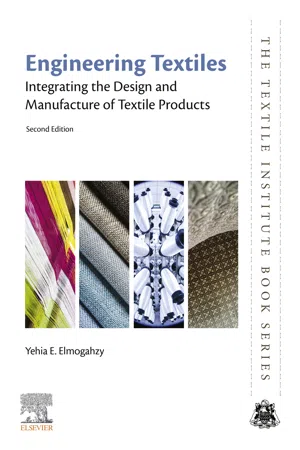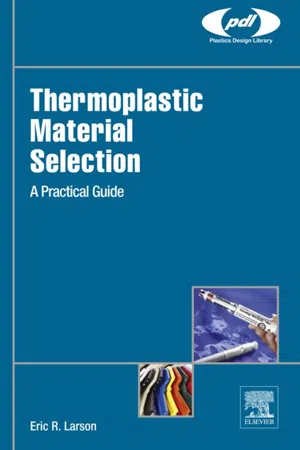Technology & Engineering
Material Index
The material index is a measure used in engineering to evaluate the performance of materials in specific applications. It is calculated by considering the properties of a material in relation to its cost, allowing engineers to make informed decisions about which material to use for a particular design. The material index helps optimize the selection of materials for various engineering projects.
Written by Perlego with AI-assistance
Related key terms
Related key terms
1 of 4
Related key terms
1 of 3
3 Key excerpts on "Material Index"
- eBook - ePub
Engineering Textiles
Integrating the Design and Manufacture of Textile Products
- Yehia Elmogahzy(Author)
- 2019(Publication Date)
- Woodhead Publishing(Publisher)
New products or highly technical products will be more complex than traditional products by virtue of the high specificity associated with their performance. As a result, they may require continuous development and ongoing search for more advanced materials to satisfy and improve specific functions. The clarity of material contribution to the product is a critical aspect of material evaluation that requires specific tasks including understanding the relative merits of using one material over another and evaluating basic material criteria such as temperature resistance, strength, and corrosion or degradation behavior. In addition, some analyses associated with determining the appropriateness of material for a certain product may be necessary. These include failure analysis, reliability and survival analysis, and safety factors [7]. In addition, material cost is often a major factor in selecting the appropriate material for a certain product. This is particularly true in engineering textiles since raw material cost may reach up to 70% of the total manufacturing cost [6]. The outcome of the material selection process may be represented by the choice of a single material with associated characteristics or two or more materials that can be mixed together to meet the desired application. In either case, it will be important to evaluate design data properties. These are the properties of the selected material in its fabricated state. The need for knowledge of these properties stems from the fact that a material in isolation could have a substantially different performance than that exhibited by the same material in a product assembly. This point is particularly true with fibrous products. Indeed, it is well established that as fibers are converted into different structures (yarns or fabrics), some of their characteristics can be altered in their magnitudes and in their relative contributions to end-product performance [8, 9] - eBook - ePub
Thermoplastic Material Selection
A Practical Guide
- Eric R. Larson(Author)
- 2015(Publication Date)
- William Andrew(Publisher)
Then, as one begins to evaluate materials, one must consider chemical families, grades, versions, property data (and/or the lack thereof), testing and verification, agency approvals, sourcing and supply chain issues, and proper processing. Sadly, many engineers and designers short circuit the selection process by jumping immediately into property data, combing databases and material data sheets to find the highest value of one specific property in order to determine the best material for the application.However, material selection is not about finding the “best” possible material for an application. Rather, it is about finding one or more suitable materials that—in combination with an effective design, proper processing, and eventual integration into a final system—result in a product that meets its intended use and satisfies (and hopefully delights) the needs of the end user. Far too often, in our quest to find the best material, we often forget that the real goal is to make the best possible product.The ultimate goal of effective material selection is to optimize the performance of the product itself. While this may seem like a trivial statement, it is an important one.5.1. What is Performance?
Performance is another one of those words that has a number of different meanings. In engineering, it is commonly used to describe the function of a system and how well it achieves its intended purpose.When we talk about product performance, we are referring to an overall assessment of a product based on an evaluation of a number of measured parameters. For example, for an automobile we may measure acceleration, handling on the road, cornering, roominess of the interior, the sound levels while driving, and riding comfort. The performance criteria for a race car will be distinctly different than for a family sedan, or for a sports coupe. For sports equipment we may measure weight, stiffness, handling at high speed, vibration characteristics, the feel in our hands, as well as output at specific loading conditions (e.g., the launch angle and spin rate of a golf ball when struck by the clubhead of a driver at a specific head velocity). For a medical device we may measure the reliability and consistency of its operation under a wide variety of use scenarios, including mis-use (unintended or intentional). - eBook - ePub
Informatics for Materials Science and Engineering
Data-driven Discovery for Accelerated Experimentation and Application
- Krishna Rajan(Author)
- 2013(Publication Date)
- Butterworth-Heinemann(Publisher)
Once the design criteria have been translated into a clear statement of function, constraints, objectives, and free variables, material indices (criteria of excellence for a particular application) can be derived and plotted on the most appropriate set of material property charts to aid material selection. The constraints can be used to screen materials from passing a selection entirely, while objectives enable formal ranking of remaining materials. Combining the material indices with trade off surfaces and penalty functions enables systematic and reproducible selection in cases where there are multiple objectives.Of course, there is always a further stage: Wider documentation about a particular material will always inform the final choice in light of processing options, finish, or simply availability. The systematic selection methods ensure that a small number of good candidates are considered at this stage, ensuring that the task of collecting and considering such documentation is manageable.This chapter has provided examples of how this process helps in, for example, the common problem of material selection for applications in which mass must be minimized. We saw how guidelines, based on performance indices corresponding to the specific geometry, can be superimposed on material property charts to indicate optimal materials. We then turned to more real-world applications, balancing potentially conflicting objectives, before addressing the frequent challenge of selecting materials for substitution into an existing design.The chapter concluded by looking to the future. As we continue to push materials closer to the limits of their performance, the need for new materials or combination of materials that can “fill the holes” in material property space is growing. We demonstrated how considering the effective material properties of new hybrid materials allows them to be compared to existing engineering materials, and how performance indices can help provide a vector for new material development.The material in the References, particularly Ashby (2011) , provides suitable further reading for those interested in this topic.References
1. Arnold, S.M., Cebon, D., Ashby, M., 2012. Materials selection for aerospace systems, NASA/TM-2012-217411.2. Ashby MF. Materials Selection in Mechanical Design fourth ed. Oxford: Butterworth Heinemann; 2011.3. Ashby, M.F., Cebon. D., Bream, C., Cesaretto, C., Ball, N., 2010. The Hybrid Synthesizer – A White Paper. Granta Design, Cambridge, UK.
Index pages curate the most relevant extracts from our library of academic textbooks. They’ve been created using an in-house natural language model (NLM), each adding context and meaning to key research topics.
Explore more topic indexes
Explore more topic indexes
1 of 6
Explore more topic indexes
1 of 4


